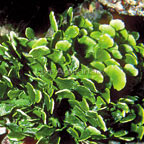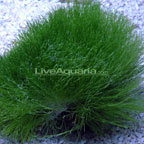|
Macroalgae such as Halimeda, Chaetomorpha, and other large celled algae are valuable additions to a saltwater aquarium. Algae serve two important roles in the ecosystem of the oceans and aquariums.Many species are great food sources for tangs, angels, and other herbivorous animals. Secondly, macroalgae reduce the existing levels of phosphates and nitrites/nitrates, providing an excellent form of natural filtration.
Algae Filters or Algae "scrubbers"
The use of "algae filters" or "algae scrubbers" has become popular in recent years, in part, because it is a natural approach to filtering water. The construction of such an algae scrubber involves simply growing macroalgae in a sump area below the aquarium or in a side mounted refugium. An established refugium can aid in the removal of pollutants in the display aquarium so that undesirable species of algae will not grow. Many aquarists use this area not only to grow macroalgae as an algae filter but also to house live sand and live rock and raise amphipods and copepods that are found in live rock. These small crustaceans are used to feed delicate fish such as
Anthias sp. and different species of Dragonets.
For best results, lighting should be provided for an extended period of time (18 to 24 hours per day) to minimize dark periods that induce CO2 production in macroalgae. The reason for the extended photoperiod is that plants only convert carbon dioxide while lighting is available. During the dark periods, plants use oxygen and release carbon dioxide. This can result in a decline in pH, and proper buffering agents need to be employed. Excessive growth should be pruned and removed as required. Macroalgae can also be kept in the main aquarium, providing valuable hiding places along with a natural food source for many fish and invertebrates.
A Few Types of Macroalgae
Macroalgae are available in a variety of shapes and colors providing exciting options for those trying to find the perfect type when aquascaping or decorating their aquarium.
  Halimeda
Halimeda
The
Hawaiian Halimeda plant usually comes as a spherical clump about the size of a baseball. This species is grown in the pristine waters of the Hawaiian Islands, and is much larger and fuller than specimens available from the Atlantic or Caribbean. It uses calcium to build a support structure within its blades. Because of this, few herbivores will feed upon this macroalgae, giving it an extended lifespan within the aquarium. Halimeda is one of the hardier and slower growing of the macroalgae.
Chaetomorpha
Chaetomorpha Algae, also known as Spaghetti Algae, is an excellent macroalgae for refugiums. Each cell grows end to end, creating long, stiff strands forming filamentous clumps resembling a ball of fishing line. Chaetomorpha is a fast growing, hardy algae that provides excellent natural filtration, absorbing nitrate and phosphate out of the water as it grows. When grown in a refugium, Chaetomorpha provides great habitat for microfauna such as copepods and amphipods. To increase the amount of nutrients this algae exports, tumble Chaetomorpha Algae in an algae filter using moderate to high lighting, and ensuring high water flow.
  Maiden's Hair
Maiden's Hair
Maiden's Hair algae has a very soft appearance providing great aesthetic value on top of all of the other benefits of macroalgae. Maiden's Hair looks like a thick mat of bright green carpet, adding an intense green color and soft flowing motion to any marine aquarium. Most Maiden's Hair is collected off of the islands of Tonga or Fiji, and comes already attached to a small piece of live rock.
There are several different species of macroalgae available to the marine hobbyist. The benefits of macroalgae cannot be understated, so if you have a marine setup, be sure to include a few of these special plants and your fish will reap the rewards.
|